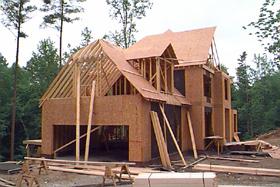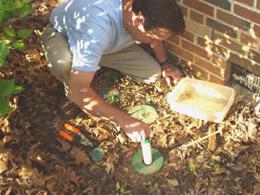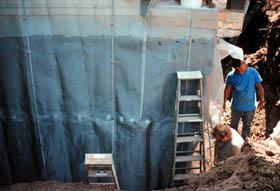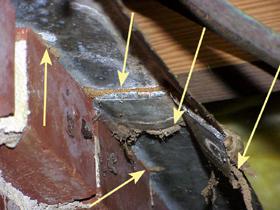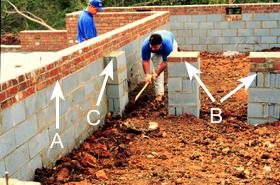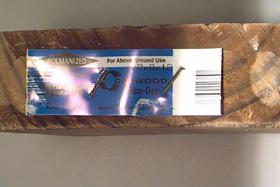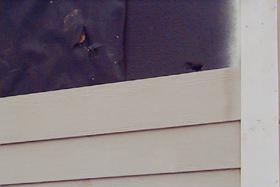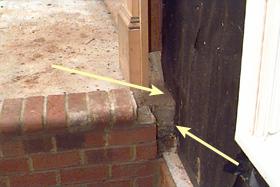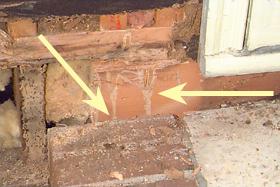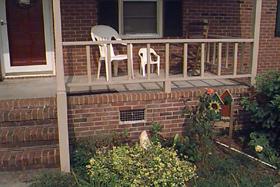The way in which homes are built affects the likelihood of termite invasion. During construction, we often create conditions that are conducive to termites or may allow them to enter the house unseen in the future. There are a number of steps that can be taken during renovations and new construction to help reduce the likelihood of termite problems. Below are some examples.
Current Options for Treating Homes Under Construction
North Carolina's Building Code requires that all new residences have some type of termite protection during construction. The method of termite protection must be a one that has been approved by the North Carolina Department of Agriculture & Consumer Services - Structural Pest Control & Pesticides Division. If you have input into the termite treatment that will be used on your new home, you may find the following links helpful:
- A list of currently approved termiticides
- State regulations governing treatment of new and existing homes
You can also contact the NCDA&CS - Structural Pest Control & Pesticides Division (919-733-6100) to obtain a copy of this information.
North Carolina currently permits four methods of termite protection for new homes:
- Soil-applied termiticides
- Termite baits
- Wood Treatment
- Stainless steel mesh
Soil-applied liquid termiticides
Conventional liquid treatments applied to the soil form a continuous chemical barrier in the soil around both sides of the foundation. For houses with crawlspaces, the soil around the piers that will support the floor system is also treated (Figure 2). This barrier should prevent foraging termites from reaching the foundation and piers and, ultimately, the wood in your house. It should be noted that only the soil adjacent to these foundation elements is treated. You do not treat the entire soil surface in the crawlspace. For slab construction (including foundations, patios and garages), the entire soil (or gravel) surface is treated before the vapor barrier is installed and the slab poured over it (Figure 3). These treatments typically require in excess of 100 gallons (depending on the size of the house) so it is not a task that most homeowners can do on their own. A properly-done soil treatment is not a one-time application. It is done in stages coordinated with all building activities from foundation construction through final grading of the soil around the building's exterior. In order for the treatment to be effective, the final phase of the application must be done after final grading and sometimes after landscaping is completed so that the treated soil is not disturbed.
For additional advice to consumers, consult the NCDA&CS page on Preconstruction Subterranean Termite Control.
Termite baits
Baits are an important option in termite prevention and control programs. In some instances, baites are used when a liquid treatment is considered unacceptable for whatever reason or they may be used in conjunction with a liquid treatment. With new construction, baiting systems are not actually installed until after final grading is completed so that the stations are not accidentally damaged or covered with soil (Figure 4).
For more information about termite baits see Termites - Baiting Systems.
Wood treatment
Another chemical alternative to soil applied termiticides is the treatment of critical structural wood members during construction. This treatment must to be done before siding and sheetrock are installed (Figure 5). Currently, the only product approved for this treatment is disodium octoborate-tetrahydrate which is sold under several trade names including BoraCare®, Bor-ram®). According to data provided by the manufacturer, termites neither feed on nor will they construct shelter tubes over borate-treated wood. However, it should be noted that there is a possibility that termites could eventually enter a slab home through an expansion joint and attack nearby untreated wood, such as baseboard molding. Also, treating the wood only stops termites from building mud tubes on the foundation wall (Figure 6). According to North Carolina regulations, a mud tube on a wall is a indication of termite activity whether or not there are termites in the mud tube or the wood. In such cases, if the residence is being sold, the WDIR ("termite inspection") must note that the building may be infested even if the wood had been treated.
Stainless steel mesh
Termi-mesh® (Termimesh Australia Pty Ltd.) is stainless steel mesh (apperture of 0.66 x 0.45 mm) that is wrapped around foundations, pipes, posts to prevent termite intrusion (Figure 7). The product is marketed in Australia and, more recently, in parts of the United States, particularly in Hawaii. Termi-mesh was installed in a house in western North Carolina during 1999. State regulations do allow the use of this product as a substitute for a conventional (liquid) or bait termite treatment in new construction.
Other barrier treatments
A great deal of ongoing research is being been directed at materials that can be placed around the foundation as physical barriers to termite invasion. Although these methods primarily target new construction, in some cases, application to existing houses appears to be feasible, though more expensive. Availability of these products in the continental United States is extremely limited and not all of these methods have been approved for use in North Carolina as the sole means of termite control for homes under construction. You will need to discuss such methods with a builder who is familiar with them or feels comfortable with their use. The following materials are currently being investigated or marketed in various areas including Australia, Hawaii and California.
- Sand - Tests have shown that a layer of sand with uniform size particles (roughly 16-grit) placed along the foundation (to a depth of at least 4 inches and trailing outward about 20") can deter movement through the soil. These particles are too large for termites to move with their mandibles ("teeth"), yet they are too small for the termites to crawl in between them or to build stable tunnels. Research in this area suggests that termites may on occasion breach these barriers and so routine inspection is still critical. The sand barrier should not be used as the sole means of termite protection and it is not currently approved as a "standalone" termite treatment in North Carolina. Therefore, people interested in such non-chemical preventive termite control measures should consider other methods.
- Stone - Granitgard® (GranitGard Pty, Ltd.) consists of finely graded stone particles which are laid beneath the concrete floors of new buildings or around foundation footers. Research has shown that termites cannot penetrate it because the particles are too large and heavy for them to shift, too hard for them to dissolve with their saliva, and too closely packed to provide a way through it. This product is not approved in North Carolina for use as the sole means of termite control for new construction. Granitgard® is mined in Australia.
Foundation Termite Barriers
Termites usually invade homes by way of the foundation, either by crawling up the exterior surface where their activity is usually obvious, or by traveling inside hollow block masonry (Figure 8). One way to try to deter their activity is to block their access points on or through the foundation.
Metal termite shields
Metal termite shields (Figure 9) have been used for decades to deter termite movement along foundation walls and piers on up to the wooden parts of the structure. The shields are rarely installed in modern construction. If installed improperly (i.e., not soldered/sealed properly) or they become damaged or deteriorated over time may allow termites to reach parts of the wooden floor system. If you choose to install termite shields, they should be made of non-corroding metal and have no cracks or gaps along the seams where sections are attached (Figure 10). If your house is being built with metal termite shielding, make sure that it extend at least two inches out and two inches down at a 45° angle from the foundation wall.
Masonry caps
In place of using termite shields on a hollow-block foundation, you can fill the block with concrete or put a few courses of solid or concrete-filled brick (which is often done anyway to level foundations). The same approach can be used with support piers in the crawlspace. Solid caps (i.e., a continuously poured concrete cap) are best at stopping termites, but are not commonly used. Concrete-filled brick caps (Figure 11) should deter termite movement or force them through small gaps that may allow you to spot them during an inspection.
Using Termite-Resistant Building Materials
Treated lumber
North Carolina Building Code requires the use of treated lumber in certain areas of a home, such as when the wood that will be in direct contact with soil or mounted on masonry in contact with the soil (e.g., the wooden "sill plate" that rests on your foundation). A number of chemicals are used to pressure-treat or surface-treat lumber, including "CCA" (Chromated Copper Arsenate), which is being phased out of use by the USEPA, as well as disodium octoborate tetrahydrate and several others. Treated lumber can also be used in other parts of your home, such as in the framing. The type and concentration of the chemical treatment will dictate where the treated lumber can or should be used. Information about the type of treatment used on the lumber is usually stamped or tagged to the wood (Figure 12). Although using treated lumber more extensively in a new home (or addition) may increase construction costs, you may decide that this is a preferred method for dealing with termites.
Resistant siding materials
"Termite-resistant" building materials are not new; some date back to the early 1900s (or earlier). There are a number of building materials that are becoming more popular in North Carolina as alternatives to conventional siding and other materials, which are typical vulnerable to termites and other wood-destroying organisms (Figure 13). The manufacturers assert that these products are termite (and decay) resistant and usually carry a long-term, limited warranty. Example of such products include HardiPlank® and HardiPanel®. As in the case of treated lumber, these products are more expensive than most conventional building materials. However, their long-term benefit in terms of durability and pest-resistance should be considered.
Remember: Termites can eat nearly any material containing cellulose. Therefore, using treated lumber is not a guarantee that termites will not invade your home and damage untreated wooden flooring or other wood, sheetrock or other celluose-containing items. However, treated lumber can help signficantly reduce termite invasion. Treated lumber and/or termite-resistant building materials are NOT substitutes for an approved termite prevention treatment or for careful maintenance and routine termite inspections of your home.
Earth-Filled Porches
Although earth or rubble-filled porches may be simple to construct, they can be problem when it comes to termite control. Termites can construct tubes along the foundation or walls of this uninspectable void and reach wooden framing unseen. Treatment of these areas can be done either by making the porch interior accessible from the crawlspace side or by drilling through the slab at approximately 12-inch intervals along the areas adjoining the wall(s) of the house. See Figure 14, Figure 15, Figure 16, Figure 17, Figure 18, and Figure 19.
Supported porches that open into the crawlspace or to the exterior help reduce problems with termites because they are accessible for inspection and treatment, if needed (Figure 20, Figure 21)
For tips on preventing termites in exisiting homes, see Termites - Preventing Problems in Existing Homes.
Publication date: June 1, 2009
Reviewed/Revised: Feb. 24, 2023
Recommendations for the use of agricultural chemicals are included in this publication as a convenience to the reader. The use of brand names and any mention or listing of commercial products or services in this publication does not imply endorsement by NC State University or N.C. A&T State University nor discrimination against similar products or services not mentioned. Individuals who use agricultural chemicals are responsible for ensuring that the intended use complies with current regulations and conforms to the product label. Be sure to obtain current information about usage regulations and examine a current product label before applying any chemical. For assistance, contact your local N.C. Cooperative Extension county center.
N.C. Cooperative Extension prohibits discrimination and harassment regardless of age, color, disability, family and marital status, gender identity, national origin, political beliefs, race, religion, sex (including pregnancy), sexual orientation and veteran status.

